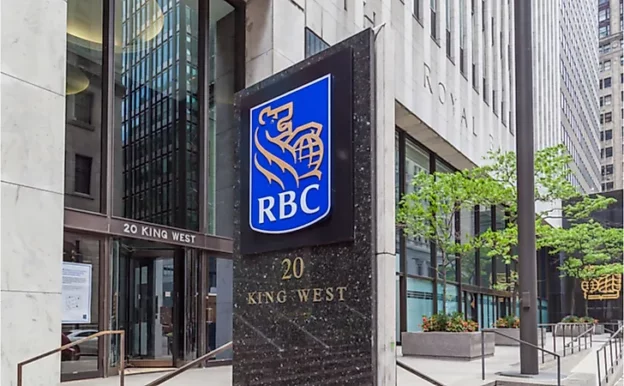Royal Bank of Canada (RBC) is the largest bank in Canada by market capitalization and one of the most influential financial institutions worldwide. Known for its strong financial performance, broad diversification, and continuous innovation, RBC remains a leader among the “Big Six” Canadian banks.
Contents
Recent Financial Performance
Strong Q1 2025 Results
-
Net Income: Around CAD 5.1 billion, representing a 43% increase compared to the same period in 2024.
-
Earnings per Share (EPS): CAD 3.54, up more than 40% year over year.
-
Return on Equity (ROE): Approximately 16.8%, reflecting efficiency in capital usage.
-
Capital Strength: The bank maintained a CET1 capital ratio of about 13.2%, well above regulatory minimums.
Continued Growth in Q3 2025
-
Net Income: Rose to CAD 5.4 billion, compared to CAD 4.5 billion a year earlier.
-
Revenue Growth: Driven by strength across all segments, including retail banking, wealth management, and capital markets.
-
Provisions for Credit Losses (PCLs): Remained elevated, as RBC prepared for potential loan defaults in sectors like real estate, consumer spending, and transportation.
Key Strategic Developments
1. HSBC Canada Acquisition
RBC finalized the acquisition of HSBC Canada, expanding its retail and commercial banking footprint. This deal has already contributed significantly to RBC’s net income and provided additional international connections. The bank is now focused on integration and delivering expected cost synergies, estimated at hundreds of millions of dollars annually.
2. AI and Digital Innovation
RBC has been heavily investing in artificial intelligence and digital tools. Initiatives include:
-
Generative AI platforms to enhance client services and trading strategies.
-
RBC Elements, an advanced data analytics system for capital markets.
-
A new AI and innovation team within RBC Capital Markets, aiming to create long-term value estimated at up to CAD 1 billion.
3. International Expansion
RBC Capital Markets has expanded in Europe, targeting a top-10 global investment bank ranking. It is strengthening operations in key markets such as the UK, France, Germany, and Spain, while recruiting senior bankers to grow its fee-based revenue.
4. Risk Management and Loan Provisions
Despite strong earnings, RBC is cautious about credit risk. Provisions for loan losses remain high as the bank prepares for challenges in real estate, high-interest debt, and slowing consumer demand.
Challenges Facing RBC
-
Economic Uncertainty: Global trade tensions, slower growth, and inflation continue to create volatility.
-
High Interest Rate Environment: While beneficial for net interest income, higher rates increase the likelihood of defaults in mortgages and consumer loans.
-
Loan Loss Provisions: Elevated PCLs indicate the bank is preparing for tougher conditions in the near term.
-
Regulatory and Environmental Pressure: RBC faces scrutiny over climate financing and regulatory expectations around sustainability.
-
Competition: Domestically from other Canadian banks and globally from large international financial institutions.
Areas of Strength
-
Diversification: Revenue streams from retail banking, wealth management, insurance, capital markets, and investor services.
-
Capital Resilience: CET1 ratio of over 13%, ensuring stability even under stress.
-
Global Presence: Operations in Canada, the U.S., Europe, and Asia, giving it a broad geographic footprint.
-
Shareholder Returns: Strong dividend policy and ongoing share buybacks reflect commitment to investor value.
Outlook
Looking forward, RBC’s performance will depend on:
-
The success of HSBC Canada integration and realization of cost synergies.
-
Effectiveness of AI investments in reducing costs and improving client services.
-
Management of credit risks in high-interest environments.
-
Growth in international markets, particularly Europe.
-
Ability to maintain balance between shareholder returns, regulatory compliance, and strategic investment.
FAQ
Q1: How profitable is RBC right now?
RBC’s profit growth has been strong, with net income exceeding CAD 5 billion per quarter in 2025.
Q2: What impact did the HSBC Canada acquisition have?
It expanded RBC’s customer base, increased net income, and strengthened its international connections.
Q3: How is RBC using AI?
RBC has launched new AI teams and platforms to enhance trading, client interaction, and data analysis, aiming for billions in long-term value.
Q4: Is RBC financially stable?
Yes. With a CET1 ratio above 13% and strong liquidity, the bank maintains resilience against economic shocks.
Q5: What risks does RBC face?
Economic slowdown, high loan defaults, regulatory pressures, and competition from global financial institutions.
Q6: Does RBC pay dividends?
Yes. RBC has a strong record of paying quarterly dividends and continues share buyback programs.
Q7: Where does RBC operate outside Canada?
RBC has a significant presence in the U.S., Europe, and Asia, with strategic growth in European capital markets.
